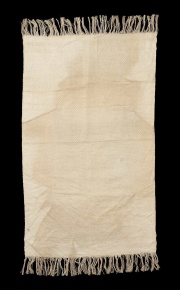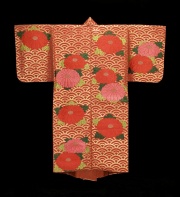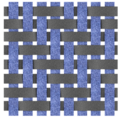Twill weave
Description
A basic weave pattern that results in parallel, diagonal ribs on the front and a smooth face on the back. Twill weaves are made by two or more weft strands alternating over and under one or more warp strands. This produces a strong durable fabric with less tendency to wrinkle or show soil than plain weaves. Twills can be divided into even-sided, warp-faced, and weft-faced. Even-sided twills have the same amount of warp and weft threads visible on both sides of the fabric. Warp-faced twills have more warp threads visible on the face side, and weft-faced twills have more weft threads visible on the face side. The pattern can be either left-handed (upper left to lower right) or right-handed (lower left to upper right). Twill weave fabric were popularly used as painting canvases by 18th and 19th century artists (Mayer 1969). They have also been commonly used for such as jackets, pants, backpacks, and even draperies.Examples of commonly twill weave fabrics are: Gabardine, Serge, Drill, Denim, Surah, wool Broadcloth, Sharkskin cloth, and some Tweeds. Herringbone is a common variation in which the twill direction is reversed at regular intervals.
Synonyms and Related Terms
herringbone weave; ligamento de sarga (Esp.)
Additional Images
Resources and Citations
- M. Joseph, Introductory Textile Science, Holt Reinhold & Winston, Fort Worth, 1986. ° R. Mayer, A Dictionary of Art Terms and Techniques, Harper and Row, New York, 1969.
- Hoechst Celanese Corporation, Dictionary of Fiber & Textile Technology (older version called Man-made Fiber and Textile Dictionary, 1965), Hoechst Celanese Corporation, Charlotte NC, 1990
- Rosalie Rosso King, Textile Identification, Conservation, and Preservation, Noyes Publications, Park Ridge, NJ, 1985
- R. J. Gettens, G.L. Stout, Painting Materials, A Short Encyclopaedia, Dover Publications, New York, 1966
- G.S.Brady, Materials Handbook, McGraw-Hill Book Co., New York, 1971 Comment: p. 248
- Ralph Mayer, A Dictionary of Art Terms and Techniques, Harper and Row Publishers, New York, 1969 (also 1945 printing)
- Hermann Kuhn, Conservation and Restoration of Works of Art and Antiquities, Butterworths, London, 1986
- Edward Reich, Carlton J. Siegler, Consumer Goods: How to Know and Use Them, American Book Company, New York City, 1937
- Random House, Webster's Encyclopedic Unabridged Dictionary of the English Language, Grammercy Book, New York, 1997
- The American Heritage Dictionary or Encarta, via Microsoft Bookshelf 98, Microsoft Corp., 1998
- Art and Architecture Thesaurus Online, http://www.getty.edu/research/tools/vocabulary/aat/, J. Paul Getty Trust, Los Angeles, 2000
- Wikipedia: Twill Access March 2025
- Textile Learner: Twill Weave: Features, Classification, Derivatives and Uses Accessed March 2025






